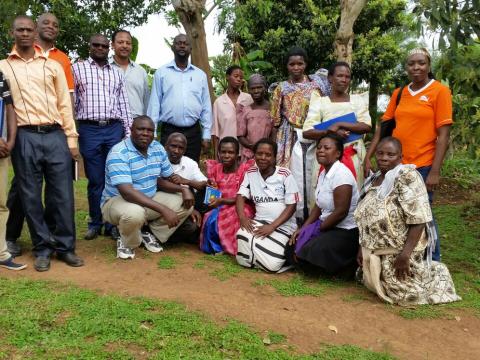We like the ‘new World-Vision’-Is the communities voice from Rakai cluster, Uganda

"We like the new World Vision" was repeatedly uttered by government and community representatives during a regional support visit to World Vision Uganda (WVU). WVU invited the regional technical team for support in reviewing the NO strategy and LEAP 3 pilot aimed at preparation for implementation in FY'2017. A regional team led by the SDO, Mr. John Makoni, paid a visit to Uganda from April 18 to 22, 2016. The team spent two days discussing with the National Office senior team before proceeding to Rakai Cluser to visit a new WVU approach that was piloted since November 2014 (but the ADPs started in the 1990s).
The program is called Household development approach (also called HH cluster approach). This program brings a group of households drawn based on geographical proximity to form a group called "Akabondo." The size of an Akabondo varies from area to area, but can normally have between 10-20 households, sometimes even more. So far, 525 such groups have been organized in Rakai. Groups go through a series of training programs after which they elect their leaders.
These groups are then used as platforms for the implementation of ADP/AP programs. In addition, group members have to identify, from among their members, potential TOTs in different disciplines (health, sanitation, model farmers, child protection, etc.). Depending on the number of Registered Child (RC), orphaned children, and children with special needs, groups agree on monitoring systems and reporting frequencies.
The groups also establish a peer-monitoring system where each HH is held accountable for the implementation of programs, for example having a complete toilet set using local materials. The group accountability is so strong due to proximity to one another. Members report on progress made in each HH during their meetings.
Without entering into the details of the approach, I want to share what I witnessed when I visited two such groups – Butanaziba (meaning - it is not yet dawn), with 28 members, and Twizembe (let's rebuild ourselves) with more than 20 members. Members of these groups hailed the new approach as it helped them to: save money, increase income, care for their children, and hold each other accountable.
Their records in child protection areas were especially astonishing: they listed activities such as issuance of birth certificates for each child (to be used for protecting underage marriage), physical protection of children ( for instance, no child goes alone to fetch water, and no child walks alone in the night). If one is found violating these principles, the groups hold the household leads accountable for the violation.
Both groups also have children movements organized and led by children themselves. They are first given training on their rights, and their environments, harmful practices and ways of reporting deviances if and when they occur. During this visit, the children sited instances where children were rescued from early marriage due to their efforts. The child leaders report on school dropouts, family pressure on members, and whether or not members have reading corners at home. For those between 12-18 years, the Akabondo has assigned councillors so that they can get life skills.
The above observations were really inspirting. The Aha! Moment was however when I learnt of a new way of referring to World Vision. This was in a meeting called to discuss the progress that government line ministry representatives from the cluster areas kept saying "we like the new WV" in reference to the new approach compared to earlier ADP approaches which was primarily community-level works with "moving targets."
This approach, they said, brings WV closer to the households, and makes integrated work possible. Government ministries, they said can now meet the groups together to disseminate information, provide training, and introducing new technologies. The "new WV" educates communities to form Akabondos, and once established, it walks with them until they reach a certain level through, in addition to other programs, continuous mentoring and follow up. The Akabondos have empowered group members to demand government services, which officials said, is a hug step to improve government accountability. The achievements are astoundingly impressive for a one-year-and-half old program.
This approach is a few steps short of the graduation approach. With some fine tuning in the process of group establishment, such as setting of targeting criteria, program packages, strengthening savings, and setting up of graduation criteria, this approach can easily deliver Child Well Being Objectives better & faster. In my opinion, use of moving targets, and unguided resource allocation in community-level interventions delivered less in transforming households. The grouping/clustering of households as economic interest groups however creates a huge opportunity to directly reach households, follow up their progress and eventually wean them out of poverty.
For those who doubted the power of the graduation approach, here is a live example from Uganda. In just less than two years, World Vision got a "new name." Imagine if this approach was launched when the ADPs started decades ago!
Maereg Tafere, PhD